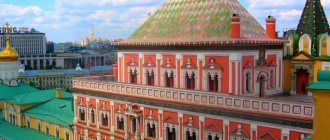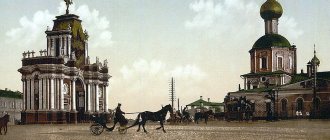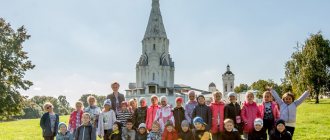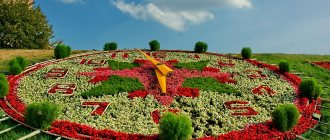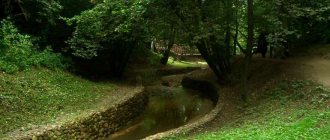One of the most beautiful places in Moscow in May is the apple orchards in the Kolomenskoye Museum-Reserve.
When apple trees bloom in the vast royal gardens, an amazing time comes: you can see snow-white lace on time-warped trunks, an emerald grass carpet under long rows of trees, and breathe in the most delicate aroma in the air.
On average, the flowering of apple trees in Moscow begins in the first - second decades of May and lasts from 7 to 17 days: early varieties bloom first, then late ones. The weather may make adjustments to the timing.
During the blossoming of apple trees, the museum-reserve organizes the “White Night in Kolomenskoye” holiday - classical music concerts, open-air exhibitions and theatrical performances are held.
Let's look into history
There is a museum-reserve in the capital of Russia - Kolomenskoye. It is a value in itself. After all, this is a former royal estate. Many pages of Russian history are connected with it. Suffice it to say that here was the country residence of the great Russian princes and tsars. Vasily the Third (1479-1533), the father of Ivan IV, and then his son, nicknamed the Terrible (1530-1584), lived in Kolomenskoye. The Russian reformer Peter the Great (1672-1725) and Catherine the Second (1729-796) came. Alexander the First (1777-1825) also visited.
The heyday of the royal estate occurred during the reign of Tsar Alexei Mikhailovich “The Quietest” (1629-1676). It was he who built a wooden palace of extraordinary beauty! It's a pity that it didn't survive.
And there is a vast park here. So here we go. And the best time to visit it is in the spring, when nature awakens.
Apple trees near the palace of Tsar Alexei Mikhailovich
After the construction of a copy of the palace of Tsar Alexei Mikhailovich in Kolomenskoye, unusually beautiful blooming apple trees were planted near it.
Their petals are deep pink.
There are also these - dark burgundy.
Fragrant flowers cling to the branches so densely that the leaves are almost invisible behind them.
Entrance to the territory of the Kolomenskoye Museum-Reserve is free. Try to choose a time and admire this truly unforgettable beauty.
Come in May
What attracts city residents to this place? The apple orchards in Kolomensky Park can easily be considered the pearl of this part of Moscow. These are large planting areas. Soft, emerald green grass carpet. All of them are thin-trunked, graceful trees, and even with intricately curved dark trunks. And snow-white lace of small flowers on them. Fairy tale!
It’s worth coming here more often to see this apple orchard in Kolomenskoye. When does this luxury bloom? Usually in the first or second ten days of May. And lasts from a week to 17 days. Unless, of course, the weather spoils everything.
It is noteworthy that the trees are planted in long rows over large areas. And this is unusual. After all, we are accustomed to the fact that apple trees usually grow next to other trees or shrubs. And there is no such continuous array. But as it turned out, it is precisely this idea that amazes. You walk through the garden - and there is no end to it.
And what a scent from this mass of blooming flowers. No perfume store can compare with so many compositions!
So don't miss the moment - come. When? In the last month of spring, it is not yet as hot as it usually is in Moscow in the summer. You probably won’t find a quieter, more pleasant and more beautiful place in the noisy capital than this park.
By the way, on these very days, museum employees organize a holiday. It’s called: “White Night in Kolomenskoye.” Exhibitions are open, music is played (including classical music), and performances are staged.
Comments (12)
Alexandra
05/19/2015 at 17:54 |
Very beautiful! I wonder how long the flowering will last...Reply
Alexandra
05/20/2015 at 15:29 |
Tell me, have the apple trees bloomed yet????
Reply
Tatiana (admin)
05/20/2015 at 20:01 |
Not yet.
Reply
Kirill
05/05/2016 at 14:07 |
Tatyana, hello! Tell me, please, are the apple trees blooming in Kolomenskoye? Is it possible to go there on Sunday?
Reply
Tatiana (admin)
05/06/2016 at 21:21 |
Hello, Kirill! I myself haven’t been to Kolomenskoye yet, but I saw a photo on social networks - cherry trees are blooming, and apple trees are just beginning to bloom. In a week, they will probably bloom in full force.
Go this weekend and next - you can't go wrong!
Reply
Alexandra
05/20/2015 at 21:51 |
thank you very much!!!
Reply
Maria
05/24/2015 at 15:26 |
Tell me, have the apple trees bloomed yet today?
Reply
Maria
05/24/2015 at 15:41 |
I already saw it on social media. networks, thank you. The apple trees are all there is to it, but there are plenty of other beauties
Reply
Irina
05/25/2015 at 10:28 |
The apple and rose trees have already bloomed??????
Reply
Olga
04/30/2016 at 20:06 |
Everything is blooming early this year. We really want not to miss the apple trees in Kolomenskoye. Perhaps someone nearby can tell you how to start flowering! Thanks a lot!
Reply
Irina
04/11/2018 at 17:21 |
Good day, friends! Tell me, can photo sessions be arranged in apple orchards without any problems or do they need to be coordinated with someone?
Reply
Alla
05/11/2018 at 12:50 |
I wonder if the apple trees are blooming yet? Or cherries?
Reply
Let's look into history
Planting of fruit trees and berry bushes on the territory of the royal estate began around the 17th century. They were described, by the way, in the “Census of Palace Gardens of 1701”. It is noted that the apple orchards in Kolomenskoye had a perfectly geometric layout. They also planted plums, cherries, and even pears. More than 6 thousand seedlings! There was also room for a vegetable garden.
Kolomenskoe village supplied its products to the royal table. Fruits and vegetables were so tasty that the royal family, after moving the capital to St. Petersburg, did not want to give them up. And the harvest was still brought from near Moscow to the imperial court. Apple orchards in Kolomenskoye today number 900 trees of different varieties. Among them there are even outlandish specimens unique to Russia.
Kolomenskoye Park is a natural landscape museum-reserve in Moscow
Kolomenskoye is one of the most popular vacation spots in Moscow. This is a whole complex consisting of a huge park, a unique architectural ensemble and a museum-reserve. Thousands of tourists visit this place every day.
The history of the unique park-museum begins back in the distant 14th century. Legend says that it was founded by the inhabitants of the city of Kolomna, burned by Khan Batu.
Historically, Kolomenskoye was the country residence of the Russian tsars, and on their orders, temples and palaces were built here.
So, in 1528-1532 the Church of the Ascension of the Lord was erected here, and in 1547-1554 - the Church of the Beheading of John the Baptist.
View from the embankment to the Church of the Ascension
The Church of the Ascension is currently included in the UNESCO World Heritage List. This is a single vertical massif, which, tapering, ends in a slender tent with a small dome.
The five-domed Church of Our Lady of Kazan, founded by Tsar Mikhail Fedorovich, is another unique structure that is part of the museum-reserve.
During the reign of Tsar Alexei Mikhailovich, a wooden palace with 270 chambers was built here, and contemporaries considered it the eighth wonder of the world.
Unfortunately, the building has not survived to this day - it gradually deteriorated and fell into disrepair. But the craftsmen, before finally dismantling the building, made detailed measurements and drawings. Centuries later, the palace was restored according to these drawings, and now it is open to the public.
Palace of Tsar Alexei Mikhailovich
Another interesting building of the palace and park ensemble is the house of Tsar Peter Alekseevich.
It was built in 1702 at the mouth of the Northern Dvina by Russian and Dutch masters, and Peter I lived in it for 2.5 months in the summer of 1702 - while the Novodvinsk fortress protecting Arkhangelsk was being built. Now anyone can come in and inspect the building from the outside and inside.
There is also a Palace Pavilion in Kolomenskoye, built in 1825. It remained as part of the Alexander Palace. It was dismantled, but the pavilion served as a tea house for the rulers of Russia.
The Vodovzvodnaya Tower was built at the end of the 17th century, and it served as a gate and at the same time provided water to the Sovereign’s courtyard.
Map of attractions in Kolomenskoye
Churches and temples, stone gates, the Vodovzvodnaya tower, the fence of the Sovereign's courtyard and the Sytny courtyard - all these are components of the palace and park complex in Kolomenskoye.
When in 1923 the architect Baranovsky founded an open-air museum of wooden architecture on the territory of the village, the buildings of Kolomenskoye were replenished with unique exhibits: the tower of the Bratsk prison, the Mokhovaya tower of Sumsky Island, the Holy Gate of the Nikolo-Korelsky Monastery. All these are rare monuments of defensive architecture in Rus'.
Kolomenskoye Park is also famous for its mystical stories.
According to legend, St. George the Victorious fought with the serpent monster right here, in Golosov Ravine. The hero's horse fell in an unequal battle, and where he struck with his hoof, springs with healing water opened, and where the horse's body fell, stones endowed with magical powers appeared. Women ask the “Maiden Stone” for offspring, men turn to the “Goose Stone” for the same.
Of course, the luxurious gardens of Kolomensky Park deserve special attention.
Palace and park complex
In tsarist times there were six of them in the estate: Red and Kazansky, New and Voznesensky, Bolshoi and Dyakovsky gardens. They appeared almost four centuries ago. Cedars and fir trees, rare for Russia, and walnuts grew here.
The rulers' gardeners grew incredible varieties of apples and pears, cherries and plums, raspberries and currants, vegetables and medicinal herbs in their gardens.
The Voznesensky Garden is a prominent representative of the palace and park ensemble, left to descendants as a legacy from the former sovereign’s garden in Kolomenskoye. Its area is 5 hectares, and it is one of the most ancient gardens in Moscow. Mostly apple trees grow there, but there are also unique 400-year-old oak trees. They say that under one of these oak trees the future Peter I, Tsarevich Peter Alekseevich, learned to read and write.
Now the Voznesensky Garden is located in the southeastern part of the estate; almost a thousand apple trees grow here.
Nearby is the exhibition “Beekeeper's Estate” and the Apothecary Garden, with growing medicinal herbs. This garden is a favorite vacation spot for Muscovites. In the warm season, here and there you can find tourists relaxing on the grass, reading and strolling in the Voznesensky Garden.
Apple orchards
Dyakovsky Garden is not too crowded; it is located behind the Golosov Ravine.
The Kazan Garden is located behind the Church of Our Lady of Kazan. It is famous for the fact that even at the time when the capital was moved to St. Petersburg, apples and pears were delivered to the royal table from here. Walnuts also grew here.
Apple trees were also planted near the new wooden palace of Alexei Mikhailovich. During the flowering period, leaves are not even visible behind the exquisite pink and burgundy flowers.
The best time to visit the gardens in Kolomenskoye Park is the end of May. In honor of the rapid flowering of apple orchards, the museum holds a special event - “White Night”. Music is played, theatrical performances and concerts are held, exhibitions and master classes are organized.
Kolomenskoye Park
In autumn, you can meet many tourists with cameras in Kolomenskoye Park. In the summer, people here walk along the Moskva River embankment, ride a boat or a motor ship, and visit annual exhibitions of sand sculptures.
In winter, Maslenitsa is celebrated on a grand scale in Kolomenskoye. They also hold concerts and large-scale events throughout the year.
A detailed description of excursion and cultural programs can be found on the official website of the museum-reserve.
Six minus three
Previously, during the tsarist era, apple orchards in Kolomenskoye consisted of six plots of land. Today only three remain. But they stand in the same place, in their rightful historical places.
The Kazan Garden was located behind the church of the same name. Apparently, the fruits from here were so good that they were taken to the sovereign's meal.
It is a prestigious place to walk in this place. And then, several centuries ago, and today. Moreover, here, according to the old schemes (from 1767!), reconstruction was done - neat paths were laid. Large flower beds appeared at their junctions. Wonderful flowers - hyacinths, tulips, and pansies - decorated them. And on one they put Diana - a statue, of course. She is the Roman goddess of flora and fauna, also of hunting. It’s clear why artists with easels often come here. When going to the apple orchard in Kolomenskoye, don’t forget to take a photo next to the patroness of all living things.
Voznesensky
The Ascension Garden got its name from the pearl of Kolomenskoye - the Church of the Ascension of the Lord. Nowadays, in one of the oldest apple orchards in Moscow, 900 apple trees of different varieties grow.
Muscovites love to come here to lie on the grass, read a book and just breathe some air.
Nearby are the indispensable companions of gardening of that time - the exhibition The Beekeeper's Estate with Beehives.
And the Apothecary Garden with strange plants and medicinal herbs.
Near the village
The Dyakovsky apple orchard is located near another church. In ancient times, serfs worked in it, caring for all the plantings and trees. They just lived nearby, in a small village.
It’s interesting that earlier the apple orchards in Kolomenskoye were decorated with... vegetable beds! Maybe that’s why the local fruits are so specially tasty? And they sold grown cucumbers with neat cabbage forks.
Even in a specially created pond, the villagers began to raise fish. The reservoir still exists. Only vacationers don’t know whether it’s the same one from Tsarist times or a new one.
There are usually not as many vacationers in this garden as in Voznesensky or Kazansky. From here there is a path to the very beautiful palace of Tsar Alexei Mikhailovich. As you walk, you see clearings with airy dandelions. And they are lined with cherry trees on all sides. Original.
One more thing. As fans of these places write, the atmosphere here is far from prim. For example, you can walk barefoot on perfectly clean lawns where bright and lush grass grows. And this is a wonderful feeling! Many people bring blankets and bags with sandwiches and sweet water here. They'll even take a bottle of wine if they're traveling with a group. And all day long they are in the “unreal” world. Sunbathing in the sun. Read books, magazines. They play different games. And they relax not only with their body, but also with their soul.
Dyakovsky apple orchard
Dyakovsky is located next to the Church of the Beheading of John the Baptist on the southern side of Golosov Ravine.
The trees in it were looked after by serf gardeners who lived nearby in the village of Dyakovo.
In those days, it was customary to create beds with vegetables for sale among fruit plantings - mainly cucumbers and cabbage. Peasants also raised fish in a “cage” - an artificial pond. Whether it's true or not, there is a pond lined with stones:
Dyakovsky is usually not as crowded as Kazansky and Voznesensky gardens.
On the way to the Palace of Alexei Mikhailovich, you come across beautiful green meadows with dandelions, lined with cherries:
